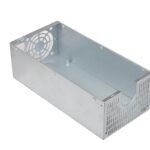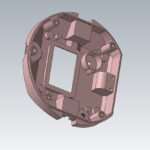If you need materials for making parts, two factors come to mind. Strength and weight are the two main factors to look at. They have a huge impact on how famous the materials are in industries. So it is helpful to compare Titanium vs. Aluminum.
There are new ways to get products to market fast. You can process cheap sheet metal and generate money fast. As a result, fewer energy-intensive materials became vital.
The fact is Titanium and Aluminum are both lightweight. You can use them for various businesses and purposes.
You need to know what each material can do to help you make the right choice, the difference between Aluminum and Titanium usage and the appropriate material for specific parts.
Comparison of Properties of Titanium and Aluminum!
Both can stand heat well and are rust-free. This means they meet the needs.
Let’s look at how these materials function.
1.Composition of the Elements
This is essential as the elements have an effect on look and behavior. Weight, corrosion resistance, and more are some of these. Some elements in Titanium are hydrogen, oxygen, nickel, and others.
Titanium is the main element, while other constituents are around 0.013 and 0.5%. Aluminum elements have magnesium, copper, iron, zinc, and others.
2.Weight
Titanium and Aluminum are lightweight. Aluminum’s density is about 2712 kg/m3. This is a lot less than Titanium’s 4500 kg/m3. It is lighter than Titanium.
But Titanium can be up to two-thirds heavier than Aluminum. The production process will use less Titanium to get its physical strength.
3.Corrosion Resistance Properties
When it comes to corrosion resistance, both can resist rust well. But, companies think Titanium resists corrosion more than Aluminum. Titanium is more inert and has superb biocompatibility.
Many use it in a lot of various industries. Aluminum builds up a layer of oxide on top of itself. This will make it more non-reactive materials.

Application of Titanium and Aluminum!
You can use the two metals for rapid prototyping and production. They have a wide range of applications. Using their applications, we can compare them from one another. Below are facts about their applications:
Titanium’s Applications
Titanium is a popular metal you can apply in various ways. The metal is tough to deal with because of its high melting point. So it adds to the cost.
- It is corrosion-resistant and has less thermal expansion.
- Use in making parts in the aerospace industry like hydraulic systems.
- Healthcare Sector – To make objects like dental implants and more.
- Applies in making bicycle parts, and others.
- Industrial applications like the production of valves and a lot more.
Applications of Aluminum
Aluminum is available worldwide. Because of its thin layer of Aluminum oxide, it does not rust. This lightweight metal helps to keep your parts from acting like a boat anchor.
Aluminum is a good conductor of current.
So, it can move a lot of heat. This makes it helpful when making objects like heat sinks. In the airplane industry, they use Aluminum in various ways. It is good for making bicycle and car frames.
Aluminum has lots of various alloys making it more durable. It is pretty helpful in the car industry.
This is true when fuel efficiency is a concern. Other uses of Aluminum include machinery, transit, etc.
QBH Production Efficiency!
QBH Technology assures to provide high-quality rapid prototyping. They have low volume sheet metal production services such as
- CNC machining
- Steel metal
- High-quality welding
- CNC turning
- Server rack and cabinet
- Sheet metal enclosure
- And others
They provide top-quality production solutions and finish design fast. The clients have the chance to test the product well. They can request changes to perfect the design before the full production starts.
QBH QC team includes experts who can support quality management. The QC process includes incoming, production, and finished inspection. An incoming inspection ensures the supplier meets our basic standards.
Production inspection prevents issues from delaying delivery. Finished inspection verifies quality and client satisfaction.
The QC team uses tools to increase efficiency and accuracy. 2D projectors include CMM equipment and micrometer calipers.
QBH team of experts has an in-depth knowledge of the metal properties. So, the company can offer suggestions and advice to help you decide. You can visit our website and learn more about what we can offer.
Which Metal You Should Use Titanium vs Aluminum?
Titanium and Aluminum are popular CNC materials. Each has specific properties making them ideal for various uses. Companies are focusing on reducing energy consumption likewise in having their products in the market fast. This is where Aluminum and Titanium are helpful.
These metals can help in several ways considered unsuitable in the past.
Some research done on metal alloys and surface technologies prove this claim. You need to consider several factors before choosing. Take note these metals have benefits and drawbacks. The following parameters will affect your decision.

1.Price
In choosing a machining metal, the cost is a priority. It is cheaper to cast and fabricate Aluminum than Titanium. For CNC machining parts and prototyping, Aluminum is a low-cost option.
Titanium has a higher metal fabrication and extraction price. This limits the metal applications in the general industry. But if the cost is not an issue, choose Titanium for machining.
2.Applications
Consider where you will use the materials. Determine if you need to expose the element to damaging conditions and if it needs to meet strength or weight standards. Keeping this in mind and other factors will help you in choosing.
Aluminum and Titanium are very useful for different applications. Some of them include satellite and plane parts, where Titanium is a popular choice. Titanium is also useful in making medical, marine, and fixtures components.
Aluminum is used to make satellite components, fittings, and medical devices. You will also find this material in the production of vehicle frames, small boats, and others that require heat.
3.Machinability
The geometrics of the end prototype is also a good factor to consider. It determines the process for custom CNC machining the metals you will use in the production of the parts. It is easier to machine the Aluminum and process it. Titanium is hard to deal with. This only means Aluminum is a top-quality choice if metal parts production is needed.
4.Machining Waste
This is another thing to think about when you’re deciding whether to use Titanium or Aluminum to make parts. Consider how complicated your design shapes are. It doesn’t matter what type of material is used, but complex geometric shapes may make it difficult to machine in some way.
Milling away extra material may be necessary. It was cheaper to use Aluminum than Titanium in this case. Sometimes, manufacturers start by making prototypes out of Aluminum, then move on to Titanium for more production.
5.Aesthetics Requirements
Surface finishes may be part of your design, but some as-milled finishes may require certain colors. When the light shines on Titanium, it looks like silver. It is also silvery white. It can be silver or dull gray, depending on the surface it is on.

Frequently Asked Questions!
Q: It’s Titanium vs. Aluminum, which metal should I pick?
A: Both of these metals are used in different ways in different industries. Sometimes, you’ll find them helpful in the same way. Your choice of metal for prototyping will depend on how you plan to use the final product. Other things to consider are cost, strength, machinability, and more.
Q: How can I tell the difference between Titanium and Aluminum?
A: Titanium is a lot more durable than Aluminum. Thus, it tends to come off in little chunks when you file Aluminum, so be careful when doing this. You can also tell them apart by their different colors. Silvery white to dull gray are two different colors of Aluminum that can be found on different surfaces. Titanium, on the other hand, is a dark silver metal.
Q: When it comes to metals, which one lasts longer?
A: Both materials are more durable, so you can use them for a longer time. However, Titanium is better at being rigid and durable than Aluminum. There are Titanium parts that can last for a long time without having any signs of wear or tear. It has better corrosion resistance and can withstand more stress, making it last longer.
Conclusion
Titanium and Aluminum are two essential metals in the prototyping business. The properties of Aluminum and Titanium make them good choices for a lot of different types of companies. This article looked at how Titanium and Aluminum are different. You also have to think about many other things before choosing one of these metals.
QBH Technology is always ready to help if you need any help. The company’s production team is highly-skilled and experienced. You can check out their website and learn more about their prototyping process using Titanium vs Aluminum. If you have questions or inquiries about the topic, feel free to comment below. We hope this post helps you decide which is ideal for your component production.




